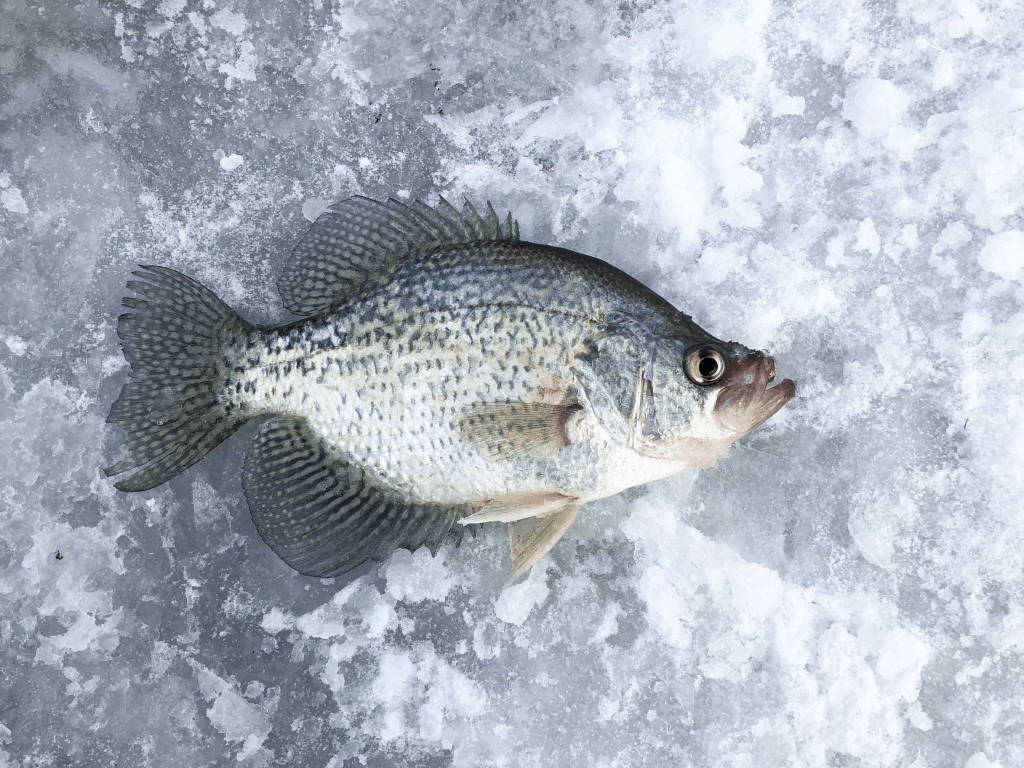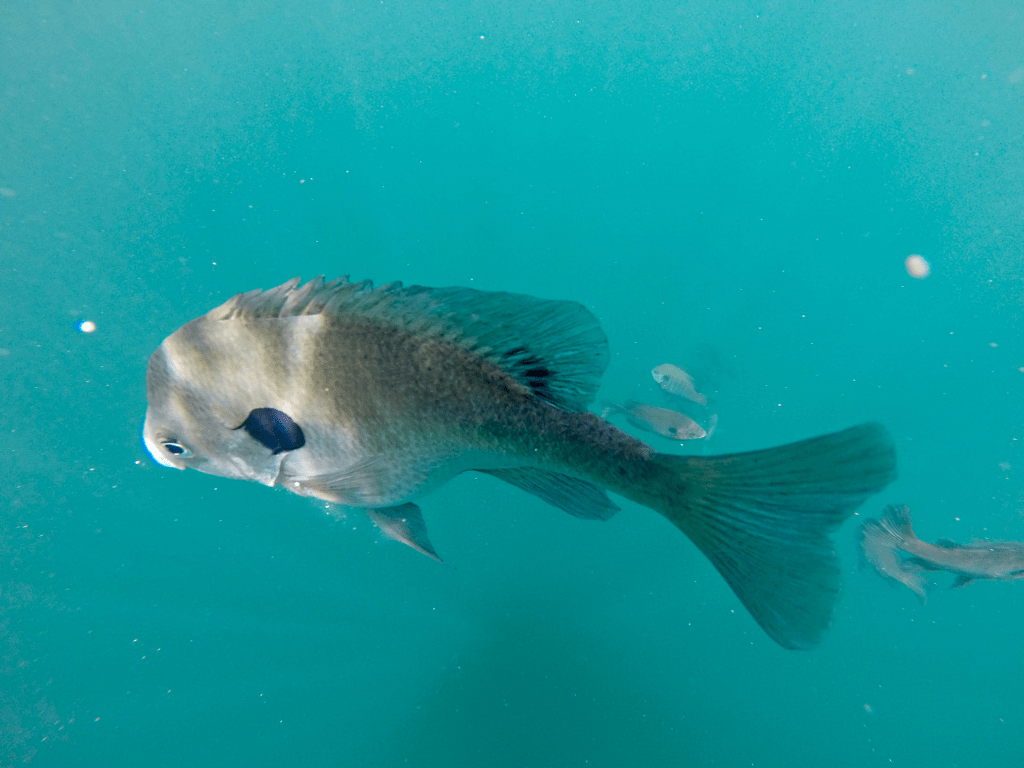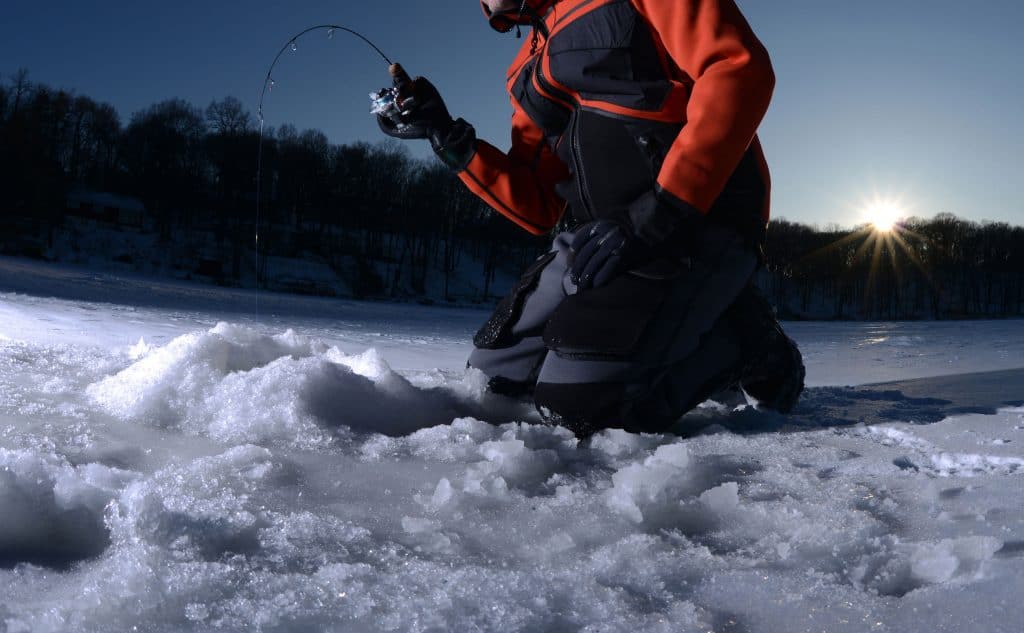Crappie are delicious catches that fishers love to bring home when ice fishing. Finding them is not always easy, though. This post will give you some tips on where to find crappie when ice fishing.
An ideal place to look for crappie is in shallower lakes with a lot of vegetation. They will swim near the grass, about two or three feet above the lake bottom, where they feed on small organisms, so you should put your bait there.
This is a great strategy to find crappie, but there are some additional tips to keep in mind when carrying it out. There is also the issue of what to do if you aren’t fishing at a shallow lake.

Look in Vegetation in Shallower Lakes
Crappie travel in groups. Figure out where the group is hanging out, and you’ll catch a lot of fish. But these groups are bound to move around, so figuring out where they’ve gone can be quite difficult.
Unless you like digging holes more than you like catching fish, I assume you’d prefer to dig as few holes as possible, so let’s start with a reliable area: a lake that’s somewhat shallow and has vegetation growing.
This is a very specific strategy, granted, but it’s one that has gotten good results, and results are what we’re after.
You are certainly aware that fish, like all creatures, need food and oxygen, so finding fish is a matter of figuring out where they like to get food and oxygen.
The reason that going to a more shallow lake and fishing in an area with plenty of weeds is a safe bet is that crappie like to eat the small organisms that live within the grass on the bottom of such lakes. They will spend a lot of time feeding there.
Now crappie do like to feed on small fish, but not until they are 6 inches long. Until then, they feed exclusively on small organisms. Grown crappie never fully outgrow this behavior, not passing up on this type of food if they come across it. Source
As I said, crappie like to stick together, so it’s inevitable that in a small lake, they’re going to cruise through areas with a lot of plants, where small organisms are abundant.
The fish also like these areas because of the good oxygen supply there. The plants provide oxygen, fish take it in.
So, you will likely find crappie swimming two or three feet above the bottom of the lake, as long as weeds are found there.
That makes this strategy quite simple. You won’t have to drop your line far, since, again, the lake is not very deep. There may be just five feet of water below the ice. You will not want your bait resting on the bottom, so once you hit the bottom, reel it back up a foot. Crappie like to eat what’s above them, so that’s why you don’t want your bait to be too low.

Choose the right bait, and you can have a lot of success by fishing in an area like this. Of course, bait is another discussion entirely. Right now, we’re just focusing on finding these fish.
The great thing about a more shallow lake is that there are simply fewer places for the crappie to go. As long as there is food and oxygen, they can thrive. On that note, a less fertile lake will probably not yield as much success.
Don’t expect the crappie to bite constantly since schools of crappie come and go. You will have slow times followed by very busy times, all due to these fishes’ tendency to travel in groups. So, patience is required. That said, their movement will be more limited in this situation compared to a larger lake.
The big limitation of this strategy is the fact that it requires you to go to a specific kind of lake. That’s not very flexible. What if you can’t find a small, shallow lake at all? Even if you can, you probably would like to go to some bigger lakes sometimes and still catch crappie. So what to do then?
Look Near Irregular Structures
If you are fishing in a deeper lake, finding crappie is a bit more complicated. More water naturally means many more places where they could be swimming. Still, there are strategies to find these fish.
To give a simple bit of advice for deep lakes: look near any sort of irregular structure underneath the water.
Now how do you know what’s underneath the water? Well, this is difficult to do unless you have a device known as a fish-finder.
Fish-finders use sonar to give a reading on the shape of the land as well as identify potential schools of fish. Sometimes, these devices even include GPS and topographical maps, giving you tons of information about lakes and really coming in handy in situations like this.
A fish-finder isn’t an absolute requirement here, but it will make this a lot easier. There are topographical maps made for fishermen that will help you find major underwater structures and know the shape of the land, so if you’re up to the challenge, you can use those.
That’s not to say there’s not a learning curve with fish-finders too, but a tech-savvy person will likely be able to figure them out quickly.
Additionally, a fish-finder is able to detect actual fish as they swim, helping you know for sure that you’ve found a good spot. So, they’re definitely worth using.
Now, I said earlier to look near “irregular structures,” but that’s a very general phrase, so let’s list some specific possibilities.
One example is a steep drop-off from a point. If you don’t know, a point is a place where the bottom is shallower than the area surrounding it, like a triangle. Fish are found there a lot.
A similar example is a reef. A reef is simply a ridge of rock or sand.
Areas like these can yield great results. Crappie will expect to eat well near such places, so it’s the perfect opportunity to strike.
If you’re at a particularly flat lake, one that does not have such obvious land features, there are still probably some unusual structures down there. According to gameandfishmag.com, you should look for “sunken creek channels, humps, cribs, sunken brush pikes and sunken roadbeds.” Any of these structures may attract crappie.
Once you identify a land feature that may attract crappie, unfortunately, when it comes to a large lake, there is still the question of depth. There are no guarantees on this issue; crappie may be close to the bottom, or they may be more mid-level. You may find them at either depth on the same day, sometimes.
Crappie love to swim suspended in open water, so if you’re aiming only for the bottom, you are probably missing out.
Earlier in the winter, crappie do stay more towards the bottom because the water as warmer and there is plenty of oxygen still there to support them. However, as the season goes on, they need to go to shallower water to find the same levels of oxygen. This happens because the oxygen gets used up, and plants down there aren’t able to produce as much in the winter.
This is a helpful bit of information. You can certainly look a bit deeper underwater if it’s early winter, but it’s not so smart in March.
In any case, try different depths, and if you have a fish-finder, use it to make this process easier. A fish-finder will certainly be able to detect a cluster of fish hanging out in open water, which is exactly what you’re looking for, so keep an eye on the device’s screen.
Patience can definitely be a factor here, particularly when you are first looking for that sweet spot. As I mentioned, crappie travel in groups, so a passing group may have you reeling in fish constantly, but once they’ve passed, you may experience a whole lot of nothing for a while.
When you find a good spot, it’s wise to see if you can find another one. That way, when you experience a lull in one hole, you can switch to another hole, where the fish may have moved to.
If the fish were spread out evenly, this process would be a whole lot easier, but unfortunately, they’ll be all clustered together, and if you’re not in their path, you’re out of luck.
However, if you find the types of underwater features I have listed, you should have plenty of success. Going to such areas is far better than random guesses. Just be sure to experiment with depth a bit, keeping in mind the time of year.
Go Fishing at Night
If you’re having trouble locating crappie, one aspect you might have forgotten is the time of day. Believe it or not, you might have more success if you try fishing at night.

Crappie actually are fairly nocturnal during the winter, meaning they’ll be more active at night than in the day.
While crappie often stay in deeper waters during the day, at night they are more aggressive and are likely to even enter the shallow areas.
The weed-filled areas that I discussed focusing on for shallow lakes may become, at night, a place to focus on for deeper lakes, as well. There’s a high chance that crappie will end up there in search of food.
Large underwater structures are always good to focus on, but even more so at night. Again, the fish will be looking aggressively for food, and they will go to the areas where they are most likely to find it. So, if you know of any humps or points, you should try to drop your line there.
Fishing at night may sound weird, but if you don’t do it, you are basically missing out on the greatest opportunity you have to catch crappie. You significantly increase your chances of catching these fish by going out at night.
If you decide to follow this advice, just make sure to be safe. Bring a light so that you’re never walking around blindly. Wear reflective clothing so others can see you. And make sure you are ready for cold temperatures.
Do all that, and you are likely to have a very fun time and catch a lot of crappie.
If you can’t stay after dark, note also that these fish tend to be more active in the early morning. So get to the water at dawn, if dusk is not an option for you.
Go Back to Past Productive Spots
Did you go fishing last Spring and catch crappie? If you did, the rules haven’t completely changed just because the lake is now frozen. You should go back to the same areas you had success at back then.
Returning to a previously successful area is always a good starting point. Sure, you will probably want to adjust as you go, but this is a simple and effective way to start finding crappie.
Granted, if this is, for some reason, a lake where the water level shifts significantly, this might not be the best approach. Otherwise, I recommend it.
If you’re going to a body of water you’ve never been to before, on the other hand, then it’s often wise to do what other people do.
Obviously, if you are reading this post, then you are already trying to find out where to go to catch crappie when ice fishing, so it would be silly for me to just tell you to ask someone else. But when it comes to a specific area, there just may be some tips that the locals know that I haven’t given, which is why it is wise to ask around if you’re going somewhere new.
Plus, if you don’t know where the types of structures I discussed are found on the lake and you don’t have a fish-finder to make it easy, then why not ask some people who know the area well where to go?
Seasoned fishermen will certainly have opinions on the best places to find crappie, so if you meet any, don’t let the opportunity go to waste. Many of them will gladly share the opinions they’ve formed from years of experience.
Now, for the benefit of your future self, if you find some successful areas, then you should find a way to mark them so you can return to them later. An easy way to do this is to use a fish-finder with a GPS. There are also ways to do this with your smartphone, which also has a GPS built in.
If you do that, assuming nothing changes drastically, you should be able to consistently reel in crappie, and you can guide others on where to find them, too.
Hopefully, the tips I’ve given here will help you capitalize on the winter season, which is a fantastic time to find crappie.
